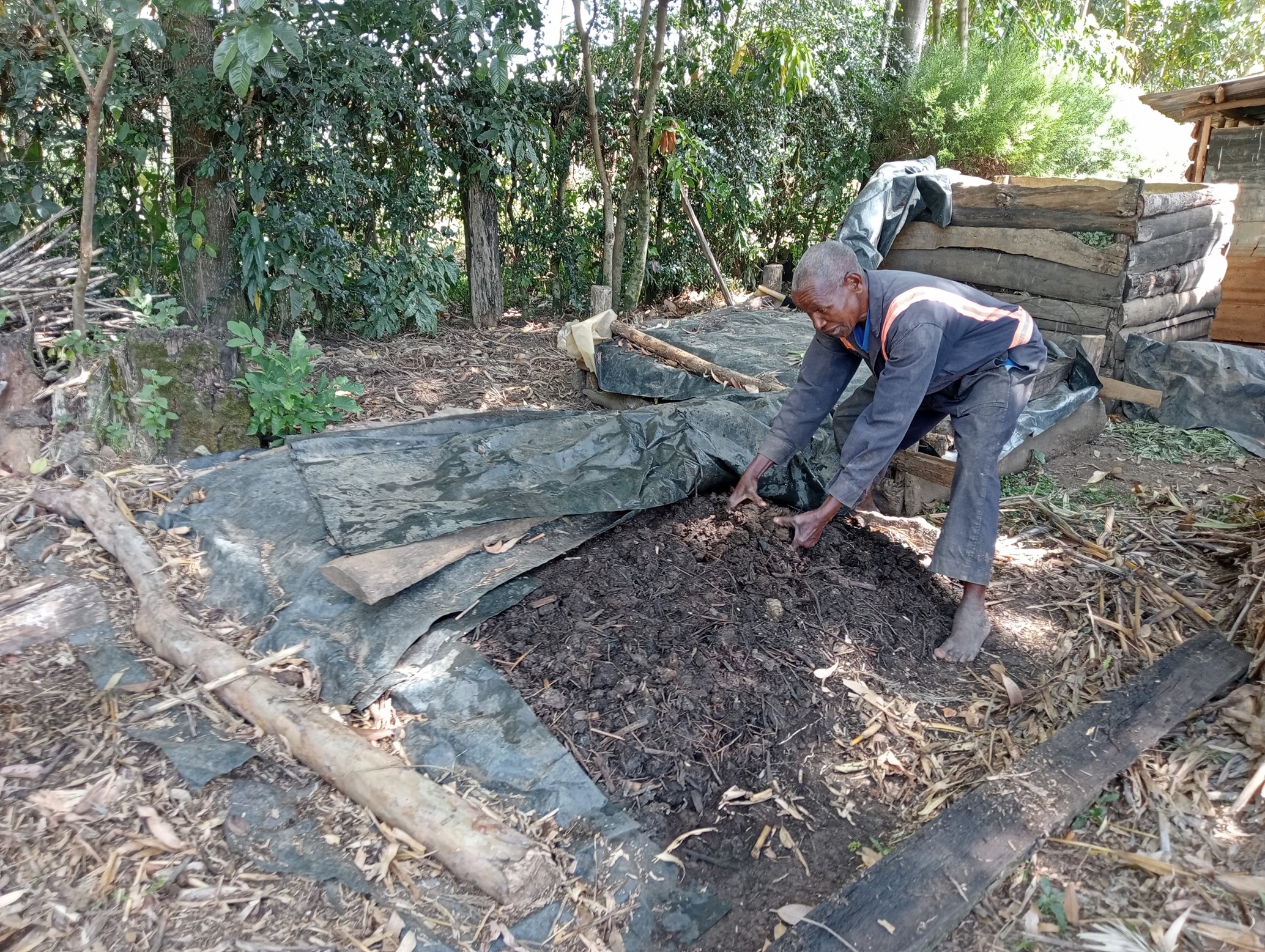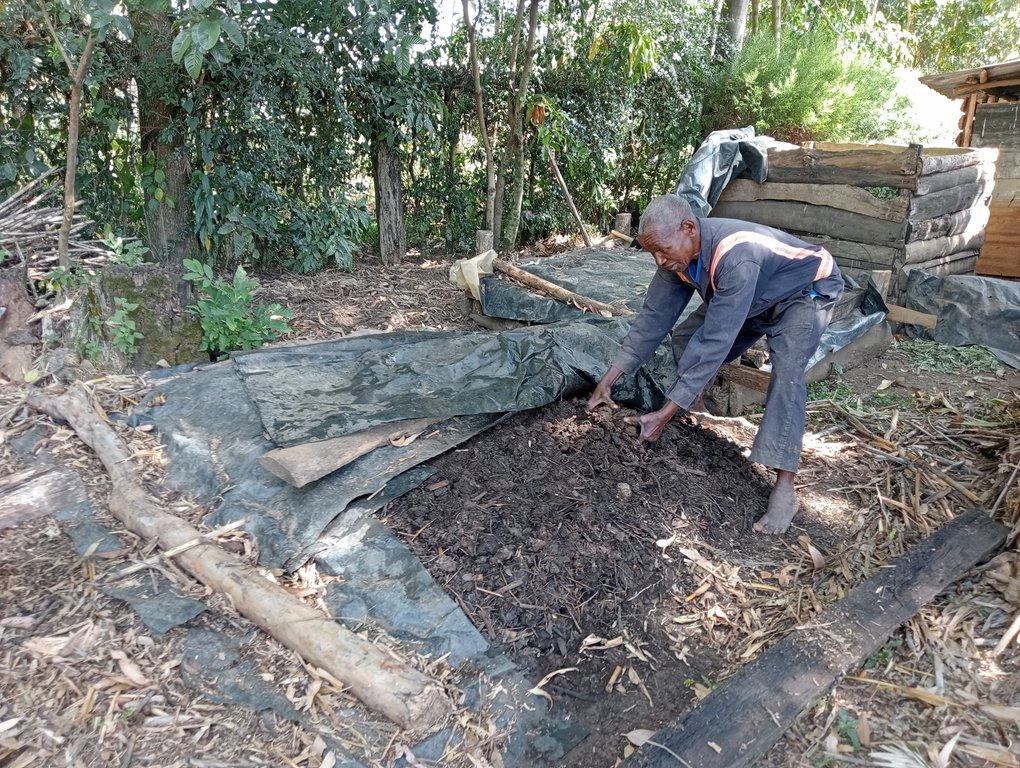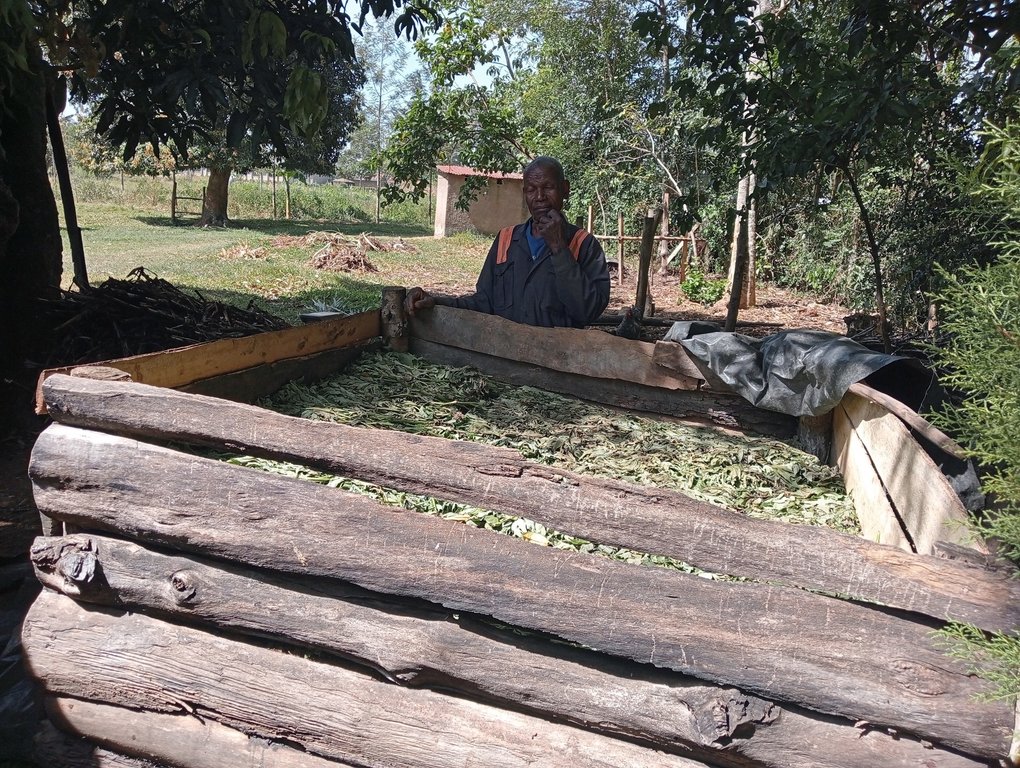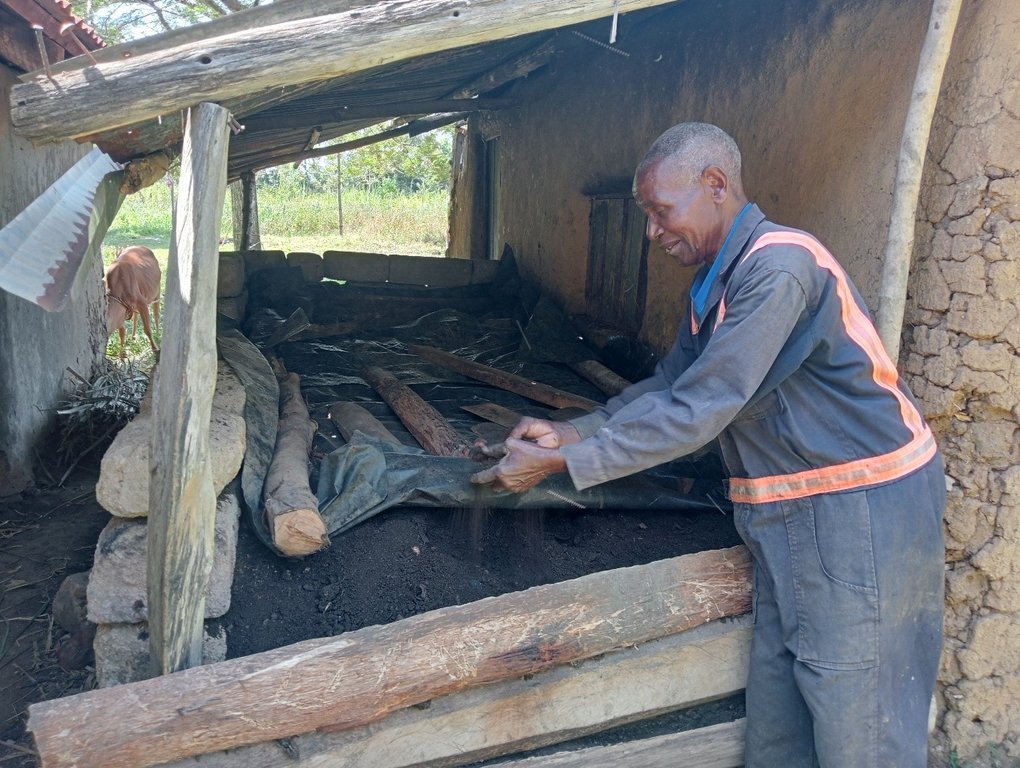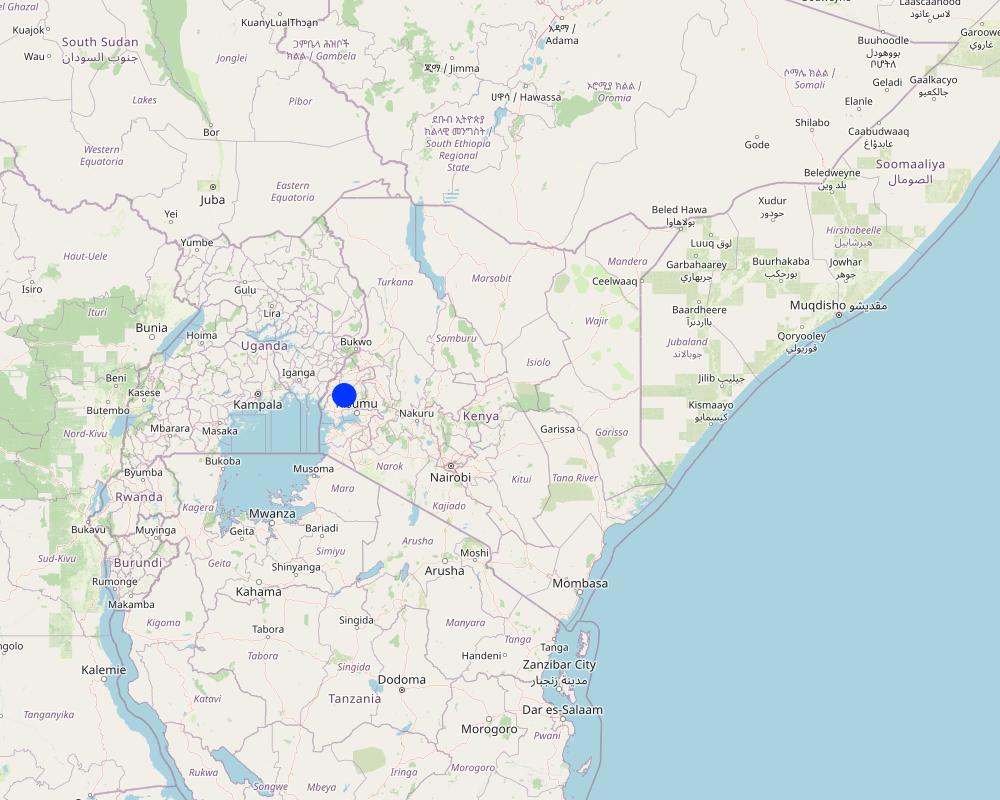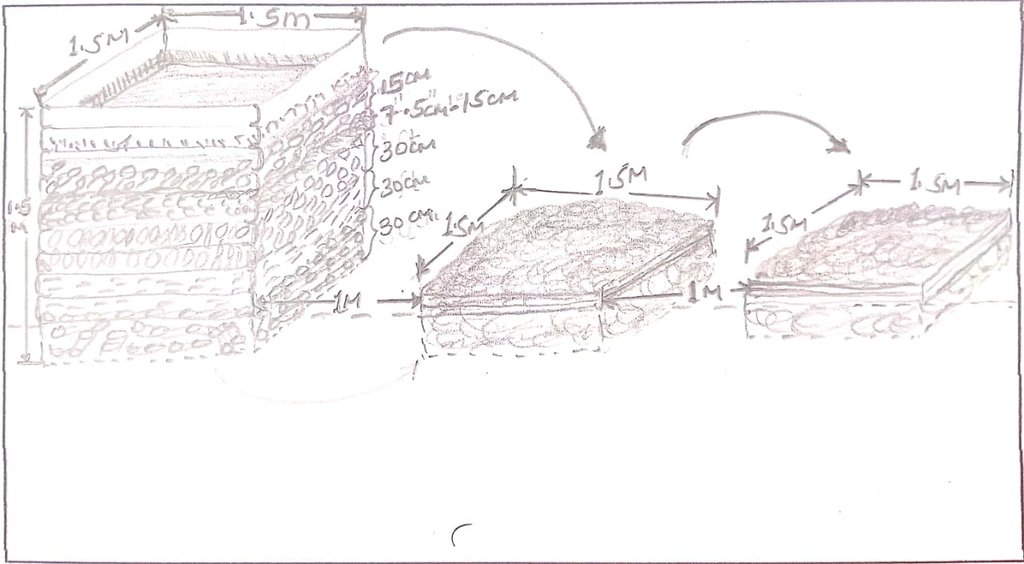Compost for organic waste management and improved crop yields [ប្រទេសកេនយ៉ា]
- ការបង្កើត៖
- បច្ចុប្បន្នភាព
- អ្នកចងក្រង៖ William Akwanyi
- អ្នកកែសម្រួល៖ George Onyango, Innocent Faith, Noel Templer, Tabitha Nekesa, Ahmadou Gaye, Siagbé Golli
- អ្នកត្រួតពិនិត្យច្រើនទៀត៖ William Critchley, Rima Mekdaschi Studer, Sally Bunning
Mbolea bora (Kiswahili)
technologies_6648 - ប្រទេសកេនយ៉ា
ពិនិត្យមើលគ្រប់ផ្នែក
ពង្រីកមើលទាំងអស់ បង្រួមទាំងអស់1. ព័ត៌មានទូទៅ
1.2 ព័ត៌មានលម្អិតពីបុគ្គលសំខាន់ៗ និងស្ថាប័នដែលចូលរួមក្នុងការវាយតម្លៃ និងចងក្រងឯកសារនៃបច្ចេកទេស
បុគ្គលសំខាន់ម្នាក់ (ច្រើននាក់)
អ្នកប្រើប្រាស់ដី:
Anyanga Matthews George
Welthungerhilfe
ប្រទេសកេនយ៉ា
អ្នកជំនាញឯកទេស SLM:
អ្នកជំនាញឯកទេស SLM:
ឈ្មោះគម្រោងដែលបានចងក្រងឯកសារ/ វាយតម្លៃលើបច្ចេកទេស (បើទាក់ទង)
Soil protection and rehabilitation for food security (ProSo(i)l)ឈ្មោះអង្គភាពមួយ (ច្រើន) ដែលបានចងក្រងឯកសារ/ វាយតម្លៃបច្ចេកទេស (បើទាក់ទង)
Deutsche Gesellschaft für Internationale Zusammenarbeit (GIZ)ឈ្មោះអង្គភាពមួយ (ច្រើន) ដែលបានចងក្រងឯកសារ/ វាយតម្លៃបច្ចេកទេស (បើទាក់ទង)
CIAT International Center for Tropical Agriculture (CIAT International Center for Tropical Agriculture) - ប្រទេសកេនយ៉ា1.3 លក្ខខណ្ឌទាក់ទងទៅនឹងការប្រើប្រាស់ទិន្នន័យដែលបានចងក្រងតាមរយៈ វ៉ូខេត
អ្នកចងក្រង និង(បុគ្គលសំខាន់ៗ)យល់ព្រមទទួលយកនូវលក្ខខណ្ឌនានាទាក់ទងទៅនឹងការប្រើប្រាស់ទិន្នន័យដែលបានចងក្រងតាមរយៈវ៉ូខេត:
បាទ/ចា៎
1.4 សេចក្តីប្រកាសស្តីពីចីរភាពនៃការពណ៌នាពីបច្ចេកទេស
តើបច្ចេកទេសដែលបានពណ៌នានេះមានបញ្ហាដែលផ្តោតលើការធ្លាក់ចុះគុណភាពដី, បើដូច្នេះវាមិនអាចត្រូវបានប្រកាសថាជាបច្ចេកទេសនៃការគ្រប់គ្រងប្រកបដោយចីរភាពទេ?
ទេ
មតិយោបល់:
Farmers who have implemented the technology have recorded good harvests from their farms. The product of manure has improved their soils.
1.5 ការយោងទៅលើកម្រងបញ្ជីសំណួរ (មួយ ឬច្រើន) នៃវិធីសាស្ត្រផ្សព្វផ្សាយ SLM (ដែលបានចងក្រងដោយទស្សនៈពិភពលោកស្តីពីវិធីសាស្ត្រ និងបច្ចេកទេសងអភិរក្ស WOCAT)
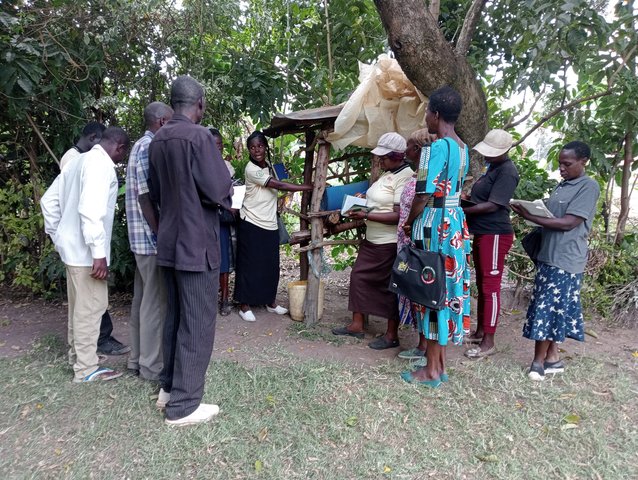
Community Resource Persons (CRP) in agricultural extension [ប្រទេសកេនយ៉ា]
Community Resource Persons (CRP) form a farmer-to-farmer learning approach that bridges the gap in agricultural extension, increases farmers' access to agricultural information (SLM knowledge), and increases the adoption of SLM practices.
- អ្នកចងក្រង៖ William Akwanyi
2. ការពណ៌នាពីបច្ចេកទេស SLM
2.1 ការពណ៌នាដោយសង្ខេបពីបច្ចេកទេស
និយមន័យបច្ចេកទេស:
Composting with on-farm organic solid waste management improves the soil sustainably and raises crop yields.
2.2 ការពណ៌នាលម្អិតពីបច្ចេកទេស
ការពណ៌នា:
Composting is a natural process of converting organic materials such as plant leaves, and food remains into a nutrient-rich soil-enhancing amendment called compost (if mainly from vegetative matter) or manure (if mainly from animal dung). It involves breaking organic matter down into humus/ compost by aerobic microorganisms - with by-products of water, heat, ammonia (NH3), and carbon dioxide (CO2). Humus is a dark and crumbly natural form of fertilizer applied to the soil to improve crop production. Composting is cost-effective since it can be made from locally available materials such as leaves, plant residues, food remains, cow dung, poultry droppings, animal urine, soil, etc. Composting is thus an on-farm solid waste management measure. When made correctly it can improve carbon sequestration in the soil (compost is carbon-rich) and prevent methane emissions (a greenhouse gas) since methane-producing microbes become inactive in aerobic conditions (in the presence of oxygen).
There are many ways of preparing compost. This method involves three key stages; mixing brown organic materials, such as twigs, and green materials, such as fresh leaves that are nitrogen-rich and moist. In the first stage, brown and green materials are layered, beginning with a 30 cm layer of twigs at the bottom, followed by a 30 cm layer of dry matter, such as maize straw chopped to a maximum of 7.5 cm. This is followed by a 30 cm layer of dry grass and dry leaves covered by a 7.5 cm – 15 cm layer of fresh cow dung. The fresh cow dung is covered by a 15 cm layer of fresh tithonia (an exotic plant) that is completely covered by a layer of ash and sprayed uniformly using 10 litres of animal urine and finally completely covered by a layer of soil or manure. All the above inputs except urine are sprayed with 10 – 20 litres of water. The pile is then completely covered with a black polythene sheet to help absorb heat, prevent the entry of rainwater, and prevent volatilization of nitrogen, i.e., the conversion of ammonium into ammonia gas, and left to decompose for 21 to 30 days.
The second stage involves mixing and transferring all the material except the twigs, to another space. The heap is again completely covered with a black polythene sheet to help absorb heat, prevent rainwater entry, and prevent nitrogen volatilization. It is again left to decompose for another 21 to 30 days. The third stage, like the second stage, involves completely mixing and transferring all the material from the second stage to another space and completely covering the heap with a black polythene sheet to help absorb heat and prevent the entry of rainwater. The contents are allowed to decompose for another 21 to 30 days, after which they are ready-to-use compost. The compost is stored under shade and covered with a black polythene sheet again to prevent nitrogen volatilization.
One heap of compost (first stage: 1.5 m by 1.5 m by 1.5 m) produces about 5 tonnes of ready-to-use compost. Composting takes about 90 days; hence, provided that all inputs are available, a farmer can produce compost 4 times each year from the same heaping point, i.e., about 20 tonnes. Normally, a 0.4-hectare farm requires about 20 tonnes of this compost. However, the amount varies from farm to farm depending on the conditions of the soil and the crop(s) to be grown. It is important that soil testing is done to determine the conditions of the soil to ensure that the compost is being used in the most effective manner.
Compost is carried to the farm on wheelbarrows and in buckets and is applied at the farm during planting time where a handful of compost is applied in the planting hole and mixed with soil before planting. It is again applied around the base of the crop and completely covered with soil. Preparation of compost in conservation agriculture situations could pose the problem of competition for plant material since plant material is used in conservation agriculture to cover the soil. To manage this, a farmer implementing both composting and conservation agriculture may have to acquire plant material for composting from other sources such as purchasing stover from other farmer who are not implementing conservation agriculture. In addition, the farmer could also use hedge trimmings as plant material for composting, especially if the farmer has a live fence.
2.3 រូបភាពនៃបច្ចេកទេស
កំណត់សម្គាល់ទូទៅនៃរូបថត/រូភាព:
Composting is a multi-stage process. The inputs/ materials in each stage must be completely covered with a black polythene sheet to help absorb heat, prevent the entry of rainwater, and prevent volatilization of nitrogen. The materials are allowed to decompose for at least 21 days in each stage before they are completely mixed and transferred to the next.
2.5 ប្រទេស/តំបន់/ទីតាំងកន្លែង ដែលបច្ចេកទេសត្រូវបានអនុវត្ត និងបានគ្រប់ដណ្តប់ដោយការវាយតម្លៃនេះ
ប្រទេស:
ប្រទេសកេនយ៉ា
តំបន់/រដ្ឋ/ខេត្ត:
Kakamega County in western Kenya
បញ្ជាក់បន្ថែមពីលក្ខណៈនៃទីតាំង:
Elang'ata Village, Bulanda Sub-location, Imanga Location, Marama Central Ward, Butere Sub-county
បញ្ជាក់ពីការសាយភាយនៃបច្ចេកទេស:
- អនុវត្តនៅកន្លែងជាក់លាក់មួយ/ ប្រមូលផ្តុំនៅតំបន់តូចៗ
តើបច្ចេកទេស (មួយ ឬច្រើន) ទាំងនោះស្ថិតនៅក្នុងតំបន់ការពារជាអចិន្ត្រៃយ៍ណាមួយដែរឬទេ?
ទេ
មតិយោបល់:
The farm where the technology is implemented is not in a protected area.
Map
×2.6 កាលបរិច្ឆេទនៃការអនុវត្ត
បង្ហាញឆ្នាំនៃការចុះអនុវត្ត:
2018
2.7 ការណែនាំពីបច្ចេកទេស
សូមបញ្ជាក់តើបច្ចេកទេសត្រូវបានណែនាំឱ្យអនុវត្តដោយរបៀបណា:
- តាមរយៈការបង្កើតថ្មីរបស់អ្នកប្រើប្រាស់ដី
- ជាផ្នែកនៃប្រព័ន្ធប្រពៃណី (> 50 ឆ្នាំ)
- តាមរយៈគម្រោង / អន្តរាគមន៍ពីខាងក្រៅ
មតិយោបល់ (ប្រភេទនៃគម្រោង ។ល។):
For years, the farmer has been converting farm wastes into manure. However, the Soil Protection and Rehabilitation of Degraded Soil for Food Security (ProSoil) project came in and taught them an improved method of composting that takes a shorter time compared with the traditional method, and prevents loss of nutrients during composting.
3. ចំណាត់ថ្នាក់នៃបច្ចេកទេស SLM
3.1 គោលបំណងចម្បង (១ ឬច្រើន) នៃបច្ចេកទេសនេះ
- ធ្វើឱ្យប្រសើរឡើងនូវផលិតកម្ម
- កាត់បន្ថយ, បង្ការ, ស្តារឡើងវិញនូវការធ្លាក់ចុះគុណភាពដី
- បន្ស៊ាំទៅនឹងការប្រែប្រួលអាកាសធាតុ/គ្រោះមហន្តរាយ និងផលប៉ះពាល់របស់វា
- កាត់បន្ថយការប្រែប្រួលអាកាសធាតុ និងផលប៉ះពាល់របស់វា
- បង្កើតផលប្រយោជន៍សេដ្ឋកិច្ច
3.2 ប្រភេទដីប្រើប្រាស់មួយប្រភេទ (ច្រើនប្រភេទ) ដែលបានអនុវត្តបច្ចេកទេស
ដីប្រើប្រាស់ចម្រុះនៅលើដីតែមួយ:
បាទ/ចា៎
បញ្ជាក់ពីប្រភេទដីច្រើនប្រភេទ (ដីដាំដំណាំ/ដីចិញ្ចឹមសត្វ/ដីព្រៃឈើ):
- ដាំដំណាំ ចិញ្ចឹមសត្វ និងឈើ

ដីដាំដំណាំ
- ដំណាំប្រចាំឆ្នាំ
- ដំណាំរយៈពេលវែង (មិនមែនឈើ)
- ប្រភេទដើមឈើធំៗ និងដើមឈើតូចៗ
ដំណាំប្រចាំឆ្នាំ - បញ្ជាក់ប្រភេទដំណាំ:
- ដំណាំចំណីសត្វ - ស្មៅ
- ធញ្ញជាតិ - ពោត
- បន្លែ - ផ្សេងៗ
- ពពួកសណ្តែក - សណ្តែកបារាំង
- ឬស/ដំណាំមើម - ដំឡូងមី
ប្រព័ន្ធដាំដុះដំណាំប្រចាំឆ្នាំ:
ការដាំពពួកសណ្តែកចន្លោះ ពោត /sorghum/millet
ដំណាំរយៈពេលវែង (មិនមែនឈើ) - បញ្ជាក់ប្រភេទដំណាំ:
- ចេក/plantain/abaca
ប្រភេទដើមឈើធំៗ និងដើមឈើតូចៗ - បញ្ជាក់ប្រភេទ:
- ផ្លែប៊ឺ
- ផ្លែឈើផ្សេងៗ
- ផ្លែស្វាយ/ផ្លែមង្ឃុត/ផ្លែត្របែក
- ផ្លែល្ហុង
ចំនួនសារដែលដាំដំណាំក្នុងមួយឆ្នាំ:
- 2
សូមបញ្ជាក់:
Long and short rain seasons
តើជាការអនុវត្តន៍ដំណាំចន្លោះ?
បាទ/ចា៎
ប្រសិនបើបាទ/ច៎ា សូមបញ្ជាក់ប្រភេទដំណាំដែលដាំចន្លោះគ្នានោះ:
Maize and beans
តើជាការអនុវត្តន៍ដំណាំវិលជុំ?
បាទ/ចា៎
បើបាទ/ច៎ា សូមបញ្ជាក់:
Some sections of the farm are left fallow during the short rains to allow for soil regeneration.

ដីសម្រាប់ចិញ្ចឹមសត្វ
ដីវាលស្មៅតូចៗ/ ផលិតកម្មចំណី:
- កាត់ និងជញ្ជូន/ គ្មានវាលស្មៅសម្រាប់ចិញ្ចឹមសត្វ
- បង្កើនវាលស្មៅ
ប្រភេទសត្វ:
- សត្វពាហនៈ - សត្វចិញ្ចឹមយកទឹកដោះ
- cattle - dairy and beef (e.g. zebu)
- បសុបក្សី
តើជាការអនុវត្តការគ្រប់គ្រងដែលរួមបញ្ចូលការដាំដំណាំ និងចិញ្ចឹមសត្វដែរឬទេ?
បាទ/ចា៎
បើបាទ/ច៎ា សូមបញ្ជាក់:
Cattle dung and poultry droppings are used as inputs in composting. Compost is applied on soil where livestock fodder is planted.
ផលិតផល និងសេវាកម្ម:
- economic security, investment prestige
- ទឹកដោះគោ
- manure as fertilizer/ energy production
- ស៊ុត
- សាច់
ប្រភេទពូជ:
សត្វពាហនៈ - សត្វចិញ្ចឹមយកទឹកដោះ
ចំនួន:
2
ប្រភេទពូជ:
cattle - dairy and beef (e.g. zebu)
ចំនួន:
3
ប្រភេទពូជ:
បសុបក្សី
ចំនួន:
10
មតិយោបល់:
There are assorted trees on the farm, and these provide litter which is an input in composting.
3.3 បន្ទាប់ពីអនុវត្តបច្ចេកទេស តើដីប្រើប្រាស់មានការប្រែប្រួលដែររឺទេ?
បន្ទាប់ពីអនុវត្តបច្ចេកទេស តើដីប្រើប្រាស់មានការប្រែប្រួលដែររឺទេ?
- ទេ (បន្តទៅសំណួរ 3.4)
3.4 ការផ្គត់ផ្គង់ទឹក
ការផ្គត់ផ្គង់ទឹកនៅកន្លែងអនុវត្តបច្ចេកទេស:
- ទឹកភ្លៀង
មតិយោបល់:
Crops are planted only during the rainy seasons since there is no irrigation.
3.5 ក្រុម SLM ដែលបច្ចេកទេសស្ថិតនៅក្នុង
- ការគ្រប់គ្រងដោយរួមបញ្ចូលការដាំដំណាំ និងការចិញ្ចឹមសត្វ
- ការគ្រប់គ្រងជីជាតិដីតាមបែបចម្រុះ
- ការគ្រប់គ្រងកាកសំណល់/ ការគ្រប់គ្រងទឹកកង្វក់
3.6 វិធានការ SLM ដែលបញ្ចូលនូវបច្ចេកទេស

វិធានការក្សេត្រសាស្ត្រ
- A2: សារធាតុសរីរាង្គ/ជីជាតិដី
- A6: ការគ្រប់គ្រងកាកសំណល់
A6: បញ្ជាក់ពីការគ្រប់គ្រងកាកសំណល់:
A 6.3: ការប្រមូលផ្តុំ
មតិយោបល់:
Plant residues, especially leaves and soft branches are collected and used as input in composting. However, some plant matter is retained in the farm to naturally decompose and turn into manure at the farm. The farmer does not collect plant residues from protected areas. He has planted tithonia at some sections of the hedges at his farm; this provides the main source of tithonia. However, he sometimes harvests tithonia from his neighbours' hedges upon request.
3.7 កំណត់ប្រភេទនៃការធ្លាក់ចុះគុណភាពដីសំខាន់ៗដែលបច្ចេកទេសនេះបានដោះស្រាយ

ការធ្លាក់ចុះសារធាតុគីមីក្នុងដី
- Cn: ការថយចុះជីជាតិ និងកាត់បន្ថយបរិមាណសារធាតុសរីរាង្គ (មិនកើតឡើងដោយការហូរច្រោះទេ)
- Ca: អាស៊ីតកម្ម
- Cp: ការបំពុលដី
មតិយោបល់:
Covering of compost-making materials and the final compost reduces loss of nitrogen through volatilization of ammonium into ammonia gas. Compost raises the pH of soils when applied at the farm. Compost contains living organisms (bacteria and fungi) that degrade soil pollutants into non-toxic substances.
3.8 ការពារ កាត់បន្ថយ ឬស្តារឡើងវិញនៃការធ្លាក់ចុះគុណភាពដី
បញ្ជាក់ពីគោលដៅរបស់បច្ចេកទេស ដែលផ្តោតទៅការធ្លាក់ចុះគុណភាពដី:
- ការការពារការធ្លាក់ចុះគុណភាពដី
- ការជួសជុល/ ស្តារឡើងវិញនៃឱនភាពដីធ្ងន់ធ្ងរ
មតិយោបល់:
Compost improves soil structure and porosity. Compost balances soil pH.
4. បច្ចេកទេសជាក់លាក់ សកម្មភាពអនុវត្ត ធាតុចូល និងថ្លៃដើម
4.1 គំនូសបច្ចេកទេសនៃបច្ចេកទេសនេះ
លក្ខណៈពិសេសនៃបច្ចេកទេស (ទាក់ទងនឺងគំនូរបច្ចេកទេស):
Stage 1: about 30 cm deep under the ground, 1.5 m long by 1.5 m wide by 1.5 m high, including the 30 cm below the ground. Constructed using timber off-cuts (locally known as magogo) supported on posts at corners using nails. From bottom: 30 cm of twigs to extend some few inches above the ground to allow air circulation, 30 cm of dry matter e.g., maize straw chopped to 7.5 cm maximum, 30 cm dry grass and leaves, 7.5 cm - 15 cm layer of fresh cow dung, 15 cm layer of fresh tithonia, layer of ash, layer of soil or manure, black polythene sheet cover.
Stages 2 and 3: about 1-ft deep under the ground, 1.5 m long by 1.5 m wide, height depends on the volume of the material.
Allow space of no more than 1 m from one stage to the other for easy of mixing and transfer of materials from one stage to the next.
ឈ្មោះអ្នកនិពន្ធ:
William Onura
កាលបរិច្ឆេទ:
26/01/2023
4.2 ព័ត៌មានទូទៅដែលពាក់ព័ន្ធនឹងការគណនាធាតុចូល និងថ្លៃដើម
កំណត់របៀបនៃការគណនាថ្លៃដើម និងធាតុចូល:
- ក្នុងឯកតាបច្ចេកទេស
បញ្ជាក់ឯកតា:
Heap of compost
បញ្ជាក់ពីទំហំនៃឯកតា (បើពាក់ព័ន្ធ):
1.5 m by 1.5 m by 1.5 m
ផ្សេងៗ/ រូបិយប័ណ្ណជាតិ (បញ្ជាក់):
KES
បើពាក់ព័ន្ធសូមកំណត់អត្រាប្តូរប្រាក់ពីដុល្លាទៅរូបិយប័ណ្ណតំបន់ (ឧ. 1 ដុល្លារ = 79.9 រៀលនៃរូបិយប័ណ្ណប្រេស៊ីល) ៖ 1 ដុល្លារ =:
122,95
កំណត់ថ្លៃឈ្នួលជាមធ្យមនៃការជួលកម្លាំងពលកម្មក្នុងមួយថ្ងៃ:
200
4.3 សកម្មភាពបង្កើត
| សកម្មភាព | រយៈពេល (រដូវកាល) | |
|---|---|---|
| 1. | Digging of pits | At least 3 months before planting time |
| 2. | Framework construction with off cuts | At least 3 months before planting time |
| 3. | Filling stage one with inputs | At least 3 months before planting time |
មតិយោបល់:
Composting takes about 3 months; hence, the farmer should have the structures for composting at least 3 months before the planting time. A farmer can produce 20 tonnes of compost from 1 heap (1.5 m by 1.5 m by 1.5 m).
4.4 ថ្លៃដើម និងធាតុចូលដែលត្រូវការសម្រាប់ការបង្កើតបច្ចេកទេស
| បញ្ជាក់ពីធាតុចូល | ឯកតា | បរិមាណ | ថ្លៃដើមក្នុងមួយឯកតា | ថ្លៃធាតុចូលសរុប | % នៃថ្លៃដើមដែលចំណាយដោយអ្នកប្រើប្រាស់ដី | |
|---|---|---|---|---|---|---|
| កម្លាំងពលកម្ម | Framework construction | Man-days | 2,0 | 200,0 | 400,0 | 100,0 |
| កម្លាំងពលកម្ម | Filling inputs | Man-days | 1,0 | 200,0 | 200,0 | 100,0 |
| សម្ភារៈ | Jembe (hoe) | No. | 1,0 | 80,0 | 80,0 | |
| សម្ភារៈ | Spade | No. | 1,0 | 90,0 | 90,0 | |
| សម្ភារៈ | Fork hoe | No. | 1,0 | 70,0 | 70,0 | |
| សម្ភារៈ | Wheelbarrow | No. | 1,0 | 800,0 | 800,0 | |
| សម្ភារៈ | Hummer | No. | 1,0 | 100,0 | 100,0 | 100,0 |
| សម្ភារៈ | Handsaw | No. | 1,0 | 200,0 | 200,0 | 100,0 |
| សម្ភារៈដាំដុះ | Twigs | Wheelbarrow | 2,0 | 100,0 | 200,0 | 100,0 |
| សម្ភារៈដាំដុះ | Dry matter | Wheelbarrow | 6,0 | 50,0 | 300,0 | 100,0 |
| សម្ភារៈដាំដុះ | Dry grass and leaves | 90 Kg sack | 3,0 | 50,0 | 150,0 | 100,0 |
| សម្ភារៈដាំដុះ | Fresh tithonia | 90 Kg sack | 3,0 | 50,0 | 150,0 | 100,0 |
| ជី និងសារធាតុពុល | Ash | 90 Kg sack | 0,4 | 200,0 | 80,0 | 100,0 |
| ជី និងសារធាតុពុល | Animal urine | 10 litre container | 1,0 | 125,0 | 125,0 | 100,0 |
| ជី និងសារធាតុពុល | Soil or manure | Wheelbarrow | 1,0 | 300,0 | 300,0 | 100,0 |
| ជី និងសារធាតុពុល | Fresh cow dung | Wheelbarrow | 3,0 | 200,0 | 600,0 | 100,0 |
| សម្ភារៈសាងសង់ | Timber off-cuts | Pieces | 16,0 | 100,0 | 1600,0 | 100,0 |
| សម្ភារៈសាងសង់ | Wooden posts | Pieces | 4,0 | 50,0 | 200,0 | 100,0 |
| សម្ភារៈសាងសង់ | Nails (assorted sizes) | Kgs | 3,0 | 200,0 | 600,0 | 100,0 |
| ផ្សេងៗ | Water | 20 litres container | 4,0 | 5,0 | 20,0 | 100,0 |
| ថ្លៃដើមសរុបក្នុងការបង្កើតបច្ចេកទេស | 6265,0 | |||||
| ថ្លៃដើមសរុបក្នុងការបង្កើតបច្ចេកទេសគិតជាដុល្លារ | 50,96 | |||||
ប្រសិនបើអ្នកប្រើប្រាស់ដីមិនមានថ្លៃដើម 100% សូមបញ្ជាក់ថានរណាដែលចំណាយថ្លៃដើមដែលនៅសល់:
ProSoil project
មតិយោបល់:
The ProSoil project through Welthungerhilfe provided hoes, fork hoes, wheelbarrows, and spades to the farmers. The costs of these implements are KES 400/- for a hoe, KES 350/- for a fork hoe, KES 4,000/- for a wheelbarrow, KES 450/- for a spade, KES 500/- for a hummer, and KES 1,000/- for a handsaw. It is assumed that the farmer will be able to use the hoe, fork hoe, spade, hummer, and handsaw over a period of 5 years, and a wheelbarrow over a period of 10 years before these implements will have depreciated to a point where they will not be useable. The cost is thus spread over the years when the farmer will be able to use the implement.
4.5 សកម្មភាពថែទាំ
| សកម្មភាព | ពេលវេលា/ ភាពញឹកញាប់ | |
|---|---|---|
| 1. | Turning at each stage | 21 - 30 days after start of each stage |
| 2. | Refilling at the first stage | At turning from the first stage |
| 3. | Distribution to the farm | When planting and at first weeding (i.e., 3rd week after planting) |
មតិយោបល់:
Turning involves complete mixing and transfer of the inputs from one stage to the next. Compost is applied at the farm during planting time where a handful of compost is applied in the planting hole and mixed with soil before planting. It is again applied around the base of the crop and completely covered with soil.
4.6 កំណត់ថ្លៃដើមសម្រាប់ការថែទាំ/ សកម្មភាពរបស់បច្ចេកទេស (ក្នុងរយៈពេលមួយឆ្នាំ)
| បញ្ជាក់ពីធាតុចូល | ឯកតា | បរិមាណ | ថ្លៃដើមក្នុងមួយឯកតា | ថ្លៃធាតុចូលសរុប | % នៃថ្លៃដើមដែលចំណាយដោយអ្នកប្រើប្រាស់ដី | |
|---|---|---|---|---|---|---|
| កម្លាំងពលកម្ម | Complete mixing and turning from stage one to stage two and from stage two to stage three | Man-days | 4,0 | 200,0 | 800,0 | 100,0 |
| កម្លាំងពលកម្ម | Refilling with new materials at the first stage | Man-days | 1,0 | 200,0 | 200,0 | 100,0 |
| កម្លាំងពលកម្ម | Transfer to storage | Man-days | 2,0 | 200,0 | 400,0 | 100,0 |
| កម្លាំងពលកម្ម | Distribution to the farm | Man-days | 2,0 | 200,0 | 400,0 | 100,0 |
| សម្ភារៈ | Hoe | No. | 1,0 | 80,0 | 80,0 | |
| សម្ភារៈ | Fork hoe | No. | 1,0 | 90,0 | 90,0 | |
| សម្ភារៈ | Spade | No. | 1,0 | 70,0 | 70,0 | |
| សម្ភារៈ | Wheelbarrow | No. | 1,0 | 400,0 | 400,0 | |
| សម្ភារៈដាំដុះ | Dry matter | Wheelbarrow | 6,0 | 50,0 | 300,0 | 100,0 |
| សម្ភារៈដាំដុះ | Dry grass and leaves | 90Kg sack | 3,0 | 50,0 | 150,0 | 100,0 |
| សម្ភារៈដាំដុះ | Fresh tithonia | 90Kg sack | 3,0 | 50,0 | 150,0 | 100,0 |
| ជី និងសារធាតុពុល | Ash | 90 Kg sack | 0,4 | 200,0 | 80,0 | 100,0 |
| ជី និងសារធាតុពុល | Animal urine | 10 litre container | 1,0 | 125,0 | 125,0 | 100,0 |
| ជី និងសារធាតុពុល | Soil or manure | Wheelbarrow | 1,0 | 300,0 | 300,0 | 100,0 |
| ជី និងសារធាតុពុល | Fresh cowdung | Wheelbarrow | 3,0 | 200,0 | 600,0 | 100,0 |
| ផ្សេងៗ | Water | 20 litres container | 4,0 | 5,0 | 20,0 | 100,0 |
| ថ្លៃដើមសរុបសម្រាប់ការថែទាំដំណាំតាមបច្ចេកទេស | 4165,0 | |||||
| ថ្លៃដើមសរុបសម្រាប់ការថែទាំដំណាំតាមបច្ចេកទេសគិតជាដុល្លារ | 33,88 | |||||
ប្រសិនបើអ្នកប្រើប្រាស់ដីមិនមានថ្លៃដើម 100% សូមបញ្ជាក់ថានរណាដែលចំណាយថ្លៃដើមដែលនៅសល់:
ProSoil project
មតិយោបល់:
The hoes, fork hoes, wheelbarrows, and spades provided by the ProSoil project through Welthungerhilfe are fixed assets and are used for years by the farmer before they can wear out. The farmer can use these implements for other work at the farm. The costs of these implements are KES 400/- for a hoe, KES 350/- for a fork hoe, KES 4,000/- for a wheelbarrow, and KES 450/- for a spade. It is assumed that the farmer will be able to use the hoe, fork hoe, and spade over a period of 5 years, and a wheelbarrow over a period of 10 years before these implements will have depreciated to a point where they will not be useable. The cost is thus spread over the years when the farmer will be able to use the implement. The twigs are reused during the refilling process since they take long to decompose.
4.7 កត្តាសំខាន់បំផុតដែលមានឥទ្ធិពលដល់ការចំណាយ
ពណ៌នាពីកត្តាប៉ះពាល់ចម្បងៗទៅលើថ្លៃដើម:
Rate of man-days vary from one place to another. It is not easy to attach monetary value to some of the input e.g., animal urine, cow dung, and water.
Exchange rate for January 2023, source: European Commission/ InfoEuro online at https://commission.europa.eu/funding-tenders/procedures-guidelines-tenders/information-contractors-and-beneficiaries/exchange-rate-inforeuro_en
5. លក្ខណៈបរិស្ថានធម្មជាតិ និងមនុស្ស
5.1 អាកាសធាតុ
បរិមាណទឹកភ្លៀងប្រចាំឆ្នាំ
- < 250 មម
- 251-500 មម
- 501-750 មម
- 751-1,000 មម
- 1,001-1,500 មម
- 1,501-2,000 មម
- 2,001-3,000 មម
- 3,001-4,000 មម
- > 4,000 មម
លក្ខណៈពិសេស/ មតិយោបល់លើរដូវភ្លៀង:
Monthly rainfall variability is high with some months such as January recording less than 5 mm of total rainfall.
បញ្ជាក់ឈ្មោះឯកសារយោងនៃស្ថានីយឧតុនិយម:
Kakamega Meteorological Station
តំបន់កសិអាកាសធាតុ
- សើម
The climate in the area favours most agricultural activities.
5.2 សណ្ឋានដី
ជម្រាលជាមធ្យម:
- រាបស្មើ (0-2%)
- ជម្រាលតិចតួច (3-5%)
- មធ្យម (6-10%)
- ជម្រាលខ្ពស់បន្តិច (11-15%)
- ទីទួល (16-30%)
- ទីទួលចោត (31-60%)
- ទីទួលចោតខ្លាំង (>60%)
ទម្រង់ដី:
- ខ្ពង់រាប
- កំពូលភ្នំ
- ជម្រាលភ្នំ
- ជម្រាលទួល
- ជម្រាលជើងភ្នំ
- បាតជ្រលងភ្នំ
តំបន់តាមរយៈកម្ពស់ :
- 0-100 ម
- 101-500 ម
- 501-1,000 ម
- 1,001-1,500 ម
- 1,501-2,000 ម
- 2,001-2,500 ម
- 2,501-3,000 ម
- 3,001-4,000 ម
- > 4,000 ម
បញ្ជាក់ថាតើបច្ចេកទេសនេះត្រូវបានអនុវត្តន៍នៅក្នុង:
- មិនពាក់ព័ន្ធទាំងអស់
មតិយោបល់ និងបញ្ចាក់បន្ថែមអំពីសណ្ឋានដី :
The farm is located at an area that is higher in altitude compared to other areas in the larger area. The average altitude for the area is 1,350m above sea level but the farm is at 1,401m above sea level.
5.3 ដី
ជម្រៅដីជាមធ្យម:
- រាក់ខ្លាំង (0-20 សម)
- រាក់ (21-50 សម)
- មធ្យម (51-80 សម)
- ជ្រៅ (81-120 សម)
- ជ្រៅខ្លាំង (> 120 សម)
វាយនភាពដី (ស្រទាប់លើ):
- មធ្យម (ល្បាយ, ល្បាប់)
វាយនភាពដី (> 20 សម ស្រទាប់ក្នុង):
- គ្រើម/ មានពន្លឺ (ខ្សាច់)
សារធាតុសរីរាង្គនៅស្រទាប់ដីខាងលើ:
- មធ្យម (1-3%)
បើអាចសូមភ្ជាប់ការពណ៌នាពីដីឱ្យបានច្បាស់ ឬព័ត៌មានដែលអាចទទួលបាន ឧ. ប្រភេទដី, pH ដី/ ជាតិអាស៊ីត, សមត្ថភាពផ្លាស់ប្តូរកាចុង, វត្តមាននីត្រូសែន, ភាពប្រៃ ។ល។:
Soil pH of most farms in the area ranges from moderately acid (5.50) to moderately alkaline (7.80).
5.4 ទឹកដែលអាចទាញមកប្រើប្រាស់បាន និងគុណភាពទឹក
នីវ៉ូទឹកក្រោមដី:
5-50 ម
ទឹកលើដីដែលអាចទាញយកប្រើប្រាស់បាន:
ល្អ
គុណភាពទឹក (មិនបានធ្វើប្រត្តិកម្ម):
ទឹកពិសារដែលគ្មានគុណភាព (តម្រូវឱ្យមានការសំអាត)
គុណភាពទឹក គឺផ្តោតទៅលើ៖:
ទាំងទឹកក្រោមដី និងលើផ្ទៃដី
តើមានបញ្ហាភាពទឹកប្រៃហូរចូលមកដែរឬទេ?
ទេ
តើទឹកជំនន់កំពុងកើតមាននៅតំបន់នេះដែររឺទេ?
ទេ
មតិយោបល់ និងលក្ខណៈពិសេសផ្សេងៗទៀតលើគុណភាព និងបរិមាណទឹក :
There are several boreholes in the area and according to interviews with some borehole owners, the depts are not more than 50 metres.
5.5 ជីវៈចម្រុះ
ភាពសម្បូរបែបនៃប្រភេទ:
- កម្រិតមធ្យម
ភាពសម្បូរបែបនៃទីជម្រក:
- កម្រិតមធ្យម
មតិយោបល់ និងលក្ខណៈពិសេសផ្សេងទៀតលើជីវចម្រុះ:
The area has high agrobiodiversity since most farms are under crops and trees.
5.6 លក្ខណៈនៃអ្នកប្រើប្រាស់ដីដែលអនុវត្តបច្ចេកទេស
នៅមួយកន្លែង ឬពនេចរ :
- ពាក់កណ្តាលពនេចរ
ទីផ្សារនៃប្រព័ន្ធផលិតកម្ម:
- ពាក់កណ្តាលពាណិជ្ជកម្ម (ផ្គត់ផ្គង់ខ្លួនឯង/ ពាណិជ្ជកម្ម)
ចំណូលក្រៅកសិកម្ម:
- ច្រើនជាង 50% នៃចំណូល
កម្រិតជីវភាព:
- មធ្យម
ឯកជន ឬក្រុម:
- ធ្វើខ្លួនឯង/ គ្រួសារ
កម្រិតប្រើប្រាស់គ្រឿងយន្ត:
- ប្រើកម្លាំងពលកម្ម
- ប្រើកម្លាំងសត្វ
យេនឌ័រ:
- ស្ត្រី
- បុរស
អាយុរបស់អ្នកប្រើប្រាស់ដី:
- យុវវ័យ
- វ័យកណ្តាល
- មនុស្សចាស់
សូមបញ្ជាក់ពីលក្ខណៈពាក់ព័ន្ធផ្សេងទៀតអំពីអ្នកប្រើប្រាស់ដី:
The farmer uses the land together with his other family members.
5.7 ទំហំផ្ទៃដីជាមធ្យមនៃដីប្រើប្រាស់ដោយអ្នកប្រើប្រាស់ដី ក្នុងការអនុវត្តបច្ចេកទេស
- < 0.5 ហិកតា
- 0.5-1 ហិកតា
- 1-2 ហិកតា
- 2-5 ហិកតា
- 5-15 ហិកតា
- 15-50 ហិកតា
- 50-100 ហិកតា
- 100-500 ហិកតា
- 500-1,000 ហិកតា
- 1,000-10,000 ហិកតា
- > 10,000 ហិកតា
តើផ្ទៃដីនេះចាត់ទុកជាទំហំកម្រិតណាដែរ ខ្នាតតូច មធ្យម ឬខ្នាតធំ (ធៀបនឹងបរិបទតំបន់)?
- ខ្នាតមធ្យម
មតិយោបល់:
Farmers with more than 2 ha in the area are considered to have large pieces of land since there is high level of land fragmentation in the area.
5.8 ភាពជាម្ចាស់ដី កម្មសិទ្ធប្រើប្រាស់ដី និងកម្មសិទ្ធប្រើប្រាស់ទឹក
ភាពជាម្ចាស់ដី:
- ឯកជន មិនមានកម្មសិទ្ធ
- ឯកជន មានកម្មសិទ្ធ
កម្មសិទ្ធិប្រើប្រាស់ដី:
- កិច្ចសន្យាជួល
- ឯកជន
កម្មសិទ្ធប្រើប្រាស់ទឹក:
- អាស្រ័យផលសេរី (មិនមានការកំណត់)
- ឯកជន
តើកម្មសិទ្ធប្រើប្រាស់ដី គឺផ្អែកលើប្រព័ន្ធច្បាប់បែបបុរាណ?
ទេ
សូមបញ្ជាក់:
Each landowner has full control of the way he/ she wants to use his/ her land.
មតិយោបល់:
The farmer has an official ownership title for his piece of land. He also leases other people's pieces of land for farming. Water in the streams and springs is freely accessed without restrictions. There is a borehole in the neighbourhood, and the managers of this borehole have set rules for accessing the water thereat.
5.9 ការប្រើប្រាស់សេវាកម្ម និងហេដ្ឋារចនាសម្ព័ន្ធ
សុខភាព:
- មិនល្អ
- មធ្យម
- ល្អ
ការអប់រំ:
- មិនល្អ
- មធ្យម
- ល្អ
ជំនួយបច្ចេកទេស:
- មិនល្អ
- មធ្យម
- ល្អ
ការងារ (ឧ. ការងារក្រៅកសិដ្ឋាន):
- មិនល្អ
- មធ្យម
- ល្អ
ទីផ្សារ:
- មិនល្អ
- មធ្យម
- ល្អ
ថាមពល:
- មិនល្អ
- មធ្យម
- ល្អ
ផ្លូវ និងការដឹកជញ្ជូន:
- មិនល្អ
- មធ្យម
- ល្អ
ទឹកផឹក និងអនាម័យ:
- មិនល្អ
- មធ្យម
- ល្អ
សេវាកម្មហិរញ្ញវត្ថុ:
- មិនល្អ
- មធ្យម
- ល្អ
មតិយោបល់:
The above rating varies from one village to the other.
6. ផលប៉ះពាល់ និងការសន្និដ្ឋាន
6.1 ផលប៉ះពាល់ក្នុងបរិវេណអនុវត្តបច្ចេកទេសដែលកើតមាន
ផលប៉ះពាល់លើសេដ្ឋកិច្ចសង្គម
ផលិតផល
ផលិតកម្មដំណាំ
គុណភាពមុន SLM:
Less than 4
គុណភាពក្រោយ SLM:
More than 8
មតិយោបល់/ ការបញ្ជាក់:
Quantity refers to the number of 90 Kg bags of maize produced per acre. Based on measurement by the farmer.
គុណភាពដំណាំ
មតិយោបល់/ ការបញ្ជាក់:
Not easy to quantify. The crops do better compared to how they could do in the past, yet he does not use inorganic fertilizers. Based on estimation by the farmer.
ផលិតកម្មចំណីសត្វ
គុណភាពមុន SLM:
2
គុណភាពក្រោយ SLM:
3 - 4
មតិយោបល់/ ការបញ្ជាក់:
Quantity refers to harvesting cycles for nappier grass from the same farm. He applies compost on the pieces of land where he has grown fodder. The fodder does better than how it used to do before when he was not applying compost.
គុណភាពចំណីសត្វ
មតិយោបល់/ ការបញ្ជាក់:
He applies compost on the pieces of land where he has grown fodder.
ផលិតកម្មសត្វ
គុណភាពមុន SLM:
1 - 3
គុណភាពក្រោយ SLM:
3 - 10
មតិយោបល់/ ការបញ្ជាក់:
Quantity refers to the amount of milk in litres from one cow. He gets more milk from his cows as compared to what he used to get before the SLM since applying compost on the pieces of land where he has grown fodder makes the fodder to grow faster. Milk production is often at the peak during early lactation months.
ហានិភ័យនៃភាពបរាជ័យរបស់ផលិតកម្ម
គុណភាពមុន SLM:
Over 50
គុណភាពក្រោយ SLM:
Less than 10
មតិយោបល់/ ការបញ្ជាក់:
Quantity refers to the percentage probability of the crop failing to do well. Quote from the farmer, '... it was 50 50 getting any produce before I started using compost ...' meaning that there was high chance that the crop could fail due to poor soils. Compost is a rich source of organic matter; hence, ensure sustainable agricultural production.
ចំណូល និងថ្លៃដើម
ការចំណាយលើធាតុចូលកសិកម្ម
គុណភាពមុន SLM:
Over 5,000
គុណភាពក្រោយ SLM:
0
មតិយោបល់/ ការបញ្ជាក់:
Quantity refers to the amount of money in Kenya shillings spend on inorganic fertilizers in a season. The farmers no longer spend money inorganic fertilizers.
ចំណូលក្នុងកសិដ្ឋាន
គុណភាពមុន SLM:
Less than 2,000
គុណភាពក្រោយ SLM:
20,000
មតិយោបល់/ ការបញ្ជាក់:
Quantity refers to the amount of money in Kenya shillings received from the sale of farm produce, including compost in a year. The farmer is able to sell surplus crop and animal products as a result of bumper harvest due to the use of compost on his farm.
ភាពសម្បូរបែបប្រភពប្រាក់ចំណូល
គុណភាពមុន SLM:
1 - 3
គុណភាពក្រោយ SLM:
More than 3
មតិយោបល់/ ការបញ្ជាក់:
Quantity refers to household income sources, including sale of surplus farm produce and compost. The farmer is able to sell surplus crop and animal products, and other on-farm products such and compost.
បន្ទុកការងារ
គុណភាពមុន SLM:
Over 5
គុណភាពក្រោយ SLM:
Less than 1
មតិយោបល់/ ការបញ្ជាក់:
Quantity refers to the number of hours that the farmer can be free in any working day. A lot of work is involved in the preparation and maintenance of compost in order to achieve the desired results.
ផលប៉ះពាល់ទៅលើវប្បធម៌សង្គម
សន្តិសុខស្បៀង/ ភាពគ្រប់គ្រាន់ខ្លួនឯង
គុណភាពមុន SLM:
About 3 months of purchasing maize
គុណភាពក្រោយ SLM:
No months when there is total lack of food in the house
មតិយោបល់/ ការបញ្ជាក់:
Quantity refers to the number of months in a year when there is total lack of food in the house, and the farmer has to buy all the food required in the house. The soils at the farm have been enhanced; hence, the farmer grows a variety of crops. Food is available in the household to sustain the family from one harvest to the next.
ចំណេះដឹង SLM / ការធ្លាក់ចុះគុណភាពដី
គុណភាពមុន SLM:
10%
គុណភាពក្រោយ SLM:
Over 90%
មតិយោបល់/ ការបញ្ជាក់:
Quantity refers to the estimated percentage of knowledge in SLM/ land management. Not only is the farmer equipped with skills on how to make compost but also with skills in other SLM technologies such as vermicomposting.
ផលប៉ះពាល់ទៅលើអេកូឡូស៊ី
ដី
សំណើមដី
គុណភាពមុន SLM:
Less than 10
គុណភាពក្រោយ SLM:
20 or more
មតិយោបល់/ ការបញ្ជាក់:
Quantity refers to the farmer's estimated soil moisture content during the dry season when soil moisture challenges are expected to be high.
គម្របដី
គុណភាពមុន SLM:
30 - 50
គុណភាពក្រោយ SLM:
60 - 80
មតិយោបល់/ ការបញ្ជាក់:
Quantity refers to the farmer's estimated percentage soil cover at the farm.
សារធាតុសរីរាង្គដី/ការបូនក្រោមដី
មតិយោបល់/ ការបញ្ជាក់:
Quantity refers to the farmer's estimated percentage of organic matter at the farm. Based on estimation by the farmer.
ជីវចម្រុះ៖ ដំណាំ, សត្វ
ដំណាំគម្រប
គុណភាពមុន SLM:
30 - 50
គុណភាពក្រោយ SLM:
60 - 80
មតិយោបល់/ ការបញ្ជាក់:
Quantity refers to the farmer's estimated percentage vegetation cover at the farm.
ភាពសម្បូរបែបនៃរុក្ខជាតិ
គុណភាពមុន SLM:
About 3
គុណភាពក្រោយ SLM:
More than 5
មតិយោបល់/ ការបញ្ជាក់:
Quantity refers to the number of plants (crops) that the farmer establishes at the farm.
ប្រភេទសត្វមានប្រយោជន៍
មតិយោបល់/ ការបញ្ជាក់:
Not easy to quantify but the number of earthworms in the farm and bees visiting the farm to look for nectar has increased.
ភាពសម្បូរបែបនៃទីជំរក
មតិយោបល់/ ការបញ្ជាក់:
Not easy to quantify but the number of earthworms in the farm has increased which is an indication of increased habitats for different animals at the farm.
បញ្ជាក់ពីការប៉ាន់ស្មាននៃផលប៉ះពាល់ក្នុងបរិវេណអនុវត្តបច្ចេកទេស (វាស់វែង):
No recorded data is available for reference. All are estimates based on the farmer's explanation or as given by him.
6.2 ផលប៉ះពាល់ក្រៅបរិវេណអនុវត្តបច្ចេកទេសដែលកើតមាន
ខូចខាតដល់ស្រែអ្នកជិតខាង
គុណភាពមុន SLM:
80
គុណភាពក្រោយ SLM:
10
មតិយោបល់/ ការបញ្ជាក់:
Quantity refers to the probability of the neighbours' farms being burned because of available plant residues. The farmer collects residues from his neighbours' farms for use in composting. The neighbours could have burned the residues leading to death of useful microorganisms (bacteria and fungi).
ផលប៉ះពាល់នៃឧស្ម័នផ្ទះកញ្ចក់
មតិយោបល់/ ការបញ្ជាក់:
Not easy to quantify. Composting improves carbon sequestration in the soil and by preventing methane emissions through aerobic decomposition, as methane-producing microbes are not active in aerobic conditions.
វាយតម្លៃផលប៉ះពាល់ក្រៅបរិវេណអនុវត្តបច្ចេកទេស (វាស់វែង):
No recorded data is available for reference. All are estimates based on the farmer's explanation or as given by him.
6.3 ភាពប្រឈម និងភាពរួសនៃបច្ចេកទេសទៅនឹងការប្រែប្រួលអាកាសធាតុ និងគ្រោះអាកាសធាតុ/ គ្រោះមហន្តរាយ (ដែលដឹងដោយអ្នកប្រើប្រាស់ដី)
ការប្រែប្រួលអាកាសធាតុ
ការប្រែប្រួលអាកាសធាតុ
| រដូវកាល | កើនឡើង ឬថយចុះ | លក្ខណៈឆ្លើយតបនៃបច្ចេកទេសទៅនឹងការប្រែប្រួលអាកាសធាតុ | |
|---|---|---|---|
| សីតុណ្ហភាពប្រចាំរដូវកាល | សើម/រដូវភ្លៀង | ថយចុះ | ល្អ |
គ្រោះអាកាសធាតុ (មហន្តរាយ)
គ្រោះមហន្តរាយអាកាសធាតុ
| លក្ខណៈឆ្លើយតបនៃបច្ចេកទេសទៅនឹងការប្រែប្រួលអាកាសធាតុ | |
|---|---|
| ភ្លើងឆេះ | ល្អ |
មតិយោបល់:
Flammable plant residues are used as inputs in composting and, thus, the risk of fire is reduced.
6.4 ការវិភាគថ្លៃដើម និងអត្ថប្រយោជន៍
តើផលចំណេញ និងថ្លៃដើមត្រូវបានប្រៀបធៀបគ្នាយ៉ាងដូចម្តេច (ទស្សនៈរបស់អ្នកប្រើប្រាស់ដី)?
រយៈពេលខ្លី:
វិជ្ជមានតិចតួច
រយៈពេលវែង:
វិជ្ជមានខ្លាំង
តើផលចំណេញ និងការថែទាំ/ ជួសជុលត្រូវបានប្រៀបធៀបគ្នាយ៉ាងដូចម្តេច (ទស្សនៈរបស់អ្នកប្រើប្រាស់ដី)?
រយៈពេលខ្លី:
វិជ្ជមានខ្លាំង
រយៈពេលវែង:
វិជ្ជមានខ្លាំង
មតិយោបល់:
Use of compost reduces the dependence on inorganic fertilizers.
6.5 ការទទួលយកបច្ចេកទេស
- 11-50%
បើអាច សូមបញ្ជាក់ពីបរិមាណ (ចំនួនគ្រួសារ និង/ ឬតំបន់គ្របដណ្តប់):
The project was implemented in the entire ward. Most farmers are preparing compost as advised in the ProSoil project.
ក្នុងចំណោមគ្រួសារទាំងអស់ដែលបានអនុវត្តបច្ចេកទេស តើមានប៉ុន្មានគ្រួសារដែលចង់ធ្វើដោយខ្លួនឯង ដោយមិនទទួលបានសម្ភារៈលើកទឹកចិត្ត/ប្រាក់ឧបត្ថម្ភ?:
- 91-100%
មតិយោបល់:
Most farmers are able to implement since the investment cost is not very high.
6.6 ការបន្សុំា
តើថ្មីៗនេះ បច្ចេកទេសនេះត្រូវបានកែតម្រូវដើម្បីបន្ស៊ាំទៅនឹងស្ថានភាពប្រែប្រួលដែរឬទេ?
ទេ
6.7 ភាពខ្លាំង/ គុណសម្បត្តិ/ ឱកាសនៃបច្ចេកទេស
| ភាពខ្លាំង/ គុណសម្បត្តិ/ ឱកាសនៅកន្លែងរបស់អ្នកប្រើប្រាស់ដី |
|---|
| With continued use of compost, there is no need for expensive inorganic fertilizers and pesticides that could also contaminate/ degrade the soil. |
| Composting is not capital intensive. |
| ភាពខ្លាំង/ គុណសម្បត្តិ/ ឱកាស ទស្សនៈរបស់បុគ្គលសំខាន់ៗ |
|---|
| There is high production in the long run even without use of inorganic fertilizers. |
| Composting is not capital intensive. |
6.8 ភាពខ្សោយ/ គុណវិបត្តិ/ ហានិភ័យនៃបច្ចេកទេស និងវិធីសាស្ត្រដោះស្រាយ
| ភាពខ្សោយ/ គុណវិបត្តិ/ ហានិភ័យ ទស្សនៈរបស់អ្នកប្រើប្រាស់ដី | តើបច្ចេកទេសទាំងនោះបានដោះស្រាយបញ្ហាដូចម្តេច? |
|---|---|
| Inputs such as tithonia are not easy to find. | Farmers can plant tithonia as hedges on their farms. |
| More labour intensive as compared to the traditional way of composting. | Farmers have to be committed. |
| ភាពខ្សោយ/ គុណវិបត្តិ/ ហានិភ័យ ទស្សនៈរបស់អ្នកចងក្រងឬបុគ្គលសំខាន់ៗ | តើបច្ចេកទេសទាំងនោះបានដោះស្រាយបញ្ហាដូចម្តេច? |
|---|---|
| More labour intensive. | Proper planning/ scheduling of farmm activities. |
7. ឯកសារយោង និងវេបសាយ
7.1 វិធីសាស្ត្រ/ ប្រភពនៃព័ត៌មាន
- តាមការចុះទីវាល ការស្រាវជ្រាវនៅទីវាល
One visit at one farm
- ការសម្ភាសន៍ជាមួយអ្នកប្រើប្រាស់ដី
One farmer interviewed at his farm. Follow-up questions on phone.
- ការសម្ភាសន៍ជាមួយអ្នកជំនាញ/ ឯកទេស
ProSoil team and project implementers from Welthungerhilfe consulted.
- ការចងក្រងពីរបាកការណ៍ និងឯកសារផ្សេងៗទៀតដែលមាន
Kakamega County Integrated Development Plan, 2018-2022 and online sources reviewed.
តើពេលណាដែលទិន្នន័យបានចងក្រង (នៅទីវាល)?
26/01/2023
មតិយោបល់:
One field visit and several follow-up consultations.
7.2 ឯកសារយោងដែលបានចេញផ្សាយ
ចំណងជើង អ្នកនិពន្ធ ឆ្នាំ ISBN:
Comparative effectiveness of different composting methods on the stabilization, maturation and sanitization of municipal organic solid wastes and dried faecal sludge mixtures, Mengistu, T., Gebrekidan, H., Kibret, K. et al., 2018, Environ Syst Res 6, 5 (2018)
មានប្រភពមកពីណា? ថ្លៃដើមប៉ុន្មាន?
Free download at https://doi.org/10.1186/s40068-017-0079-4
7.3 ការភ្ជាប់ទៅកាន់ព័ត៌មានពាក់ព័ន្ធលើប្រព័ន្ធអនឡាញ
ចំណងជើង/ ពណ៌នា:
Composting Recycling Naturally: Simple Steps for Starting at Home
វេបសាយ:
https://scdhec.gov/sites/default/files/Library/OR-1705.pdf
7.4 មតិយោបល់ទូទៅ
1. Provide a function to be able to link the documented SLM to similar work that has been documented in other databases e.g., LandPortal, UNCCD, etc.
2. Some of the impacts (section 6) cannot be quantified.
ការតភ្ជាប់ និងម៉ូឌុល
ពង្រីកមើលទាំងអស់ បង្រួមទាំងអស់ការតភ្ជាប់

Community Resource Persons (CRP) in agricultural extension [ប្រទេសកេនយ៉ា]
Community Resource Persons (CRP) form a farmer-to-farmer learning approach that bridges the gap in agricultural extension, increases farmers' access to agricultural information (SLM knowledge), and increases the adoption of SLM practices.
- អ្នកចងក្រង៖ William Akwanyi
ម៉ូឌុល
គ្មានម៉ូឌុល


